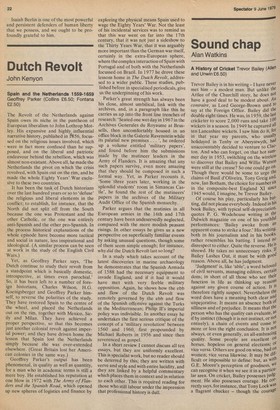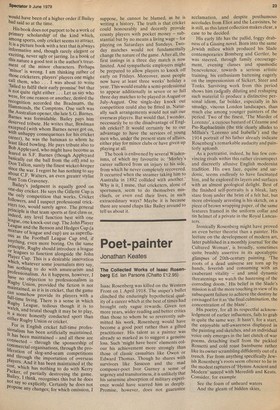Sound chap
Alan Watkins
A History of Cricket Trevor Bailey (Allen and Unwin £6.50) Trevor Bailey is in his writing — I have never met him — a modest man. But unlike the Attlee of the Churchill story, he does not have a good deal to be modest about. A14 contraire, as Lord George-Brown used to say at the Foreign Office. Bailey did the double eight times. He was, in 1959, the last cricketer to score 2,000 runs and take 100 wickets in a season. In 1949 he captured all ten Lancashire wickets. I saw him do it, for in that year my parents, who usuallY holidayed in Tenby or Aberystwyth, had unaccountably decided to venture to Clacton. And who can forget, on that hot summer day in 1953, switching on the wireless to discover that Bailey and Willie Watson were still at the crease? So one could go on. Though there would be some to urge the claims of Basil d'Oliveira, Tony Greig and, now, Ian Botham, the choice for number sut in the composite-best England XI since 1945 would, I imagine, be Trevor Bailey. Of course his play, particularly his batting, did not please everybody. Indeed in lus book Bailey, with typical self-depreciation, quotes P. G. Wodehouse writing in the Dulwich magazine on one of his youthful performances: 'Bailey awoke from an apparent coma to strike a four.' His writing, both in his journalism and in his books, rather resembles his batting. I intend n.0 disrespect to either. Quite the reverse. He Is, shrewd. He takes no unnecessary risks. II Bailey Lashes Out, it must be with good reason. Above all, he has judgment. 'Judgment' is, like 'able', a word beloved of civil servants, managing editors, certa1.0 dons; in short of all those who see their function in life as thinking up reason.s against any given course of action. It is therefore rightly suspect. Nevertheless the word does have a meaning both clear arid unpejorative. It means an absence both of silliness and of prejudice. It means that the person who has the quality can evaluate, as if by instinct (though it is not instinct, or not entirely), a chain of events and come t° more or less the right conclusion. It is riot always, or even generally, an all-embracing quality. Some people are excellent 00 horses, hopeless on general elections; of vice versa. Others are good on wine, bad ir women; vice versa likewise. It may be difficult or impossible to define: but, as with G.E. Moore's perception of goodness,'e can recognise it when we see it in a particular area. On cricket, Bailey possesses judgment. He also possesses courage. He correctly says, for instance, that Tony Lock vv95 a flagrant chucker — though the courage would have been of a higher order if Bailey had said so at the time.
His book does not purport to be a work of Primary scholarship' of the kind which, among sports, only cricket seems to attract. It is a picture book with a text that is always informative and, though rarely elegant or exciting, never ugly or jarring. In a book of this nature a good test is the author's treatment of the minor characters. Perhaps 'minor' is wrong. I am thinking rather of those cricketers, players' players one might call them, who . . . I was about to write 'failed to fulfil their early promise' but that is not quite right either . . . Let us say who were, for one reason or another, denied the recognition accorded the Bradmans, the Hammonds, the Comptons. One such was the Australian opener, the late S.G. Barnes. Barnes was formidable. Bailey pays him deserved tribute. He writes that, Bradman excepted (with whom Barnes never got on, with unhappy consequences for his cricket career), he was the batsman to whom he least liked bowling. He pays tribute also to Bob Appleyard, who might have become as feared as S.F. Barnes (though Appleyard basically cut the ball from the off) and to Don Tallon, surely the finest wicket-keeper since the war. I regret he has nothing to say about C.F. Walters, an even greater stylist than Tom Graveney. Bailey's judgment is equally good on one-day cricket. He says the Gillette Cup is the only competition that works. Cricket followers, and I suspect professional cricketers too, would surely agree. The general Principle is that team sports at first class or, indeed, any level function best with one league, one knock-out cup. The John Player 'League and the Benson and Hedges Cup (a mixture of league and cup) are as superfluous as the Football League Cup and, if anything, even more boring. On the same Principle, Rugby should introduce a league or leagues to function alongside the John Player Cup. This is a desirable innovation Which, whatever some journalists may say, has nothing to do with amateurism and Professionalism . As it happens, however, I have no objection to professionalism in Rugby Union, provided the fiction is not maintained, as it is in cricket, that the game can somehow provide its players with a full-time living. There is a sense in which Rugby League, tedious though it is to Watch, and brutal though it may be to play, is a more honestly conducted sport than either Rugby Union or cricket. For in English cricket full-time professionalism has been artificially maintained. It has been maintained — and all these are connected — through the sponsorship of commercial organisations, through the proliferation of slog-and-seam competitions and through the importation of overseas Players. And it.has been maintained at the cost, which has nothing to do with Kerry Packer, of partially destroying the game. Bailey, I think, recognises this but he does not say so explicitly. Certainly he does not propose any changes; for which omission, I suppose, he cannot be blamed, as he is writing a history. The truth is that cricket could honourably and decently provide county players with pocket money — substantial but by no means a living wage — for playing on Saturdays and Sundays. Twoday matches would not fundamentally change the nature of the game. After all, the first innings in a three day match is now limited. And sympathetic employers might be prepared to .allow players to knock off early on Fridays. Moreover, most people now have at least three weeks' holiday a year. This would enable a semi-professional to appear additionally in seven or so full three day matches to be played in August or July-August. One single-day knock out competition could also be fitted in. Naturally such arrangements would not suit our overseas players. But would that, I wonder, necessarily be to the disadvantage of English cricket? It would certainly be to our advantage to have the services of young men who, under the present state of affairs, either play for minor clubs or have given up playing at all.
The book is enlivened by several Wisdenisms, of which my favourite is: 'Morley's career suffered from an injury to his side, from which he never completely recovered. It occurred when the steamer taking him to Australia in 1882 collided with another.' Why is it, I muse, that cricketers, alone of sportsmen, seem to do themselves mischiefs, or even end their lives, in such extraordinary ways? Maybe it is because there are sound chaps like Bailey around to tell us about it.











































 Previous page
Previous page